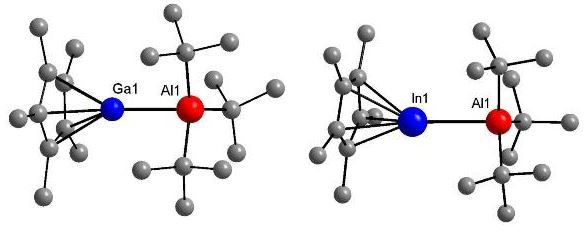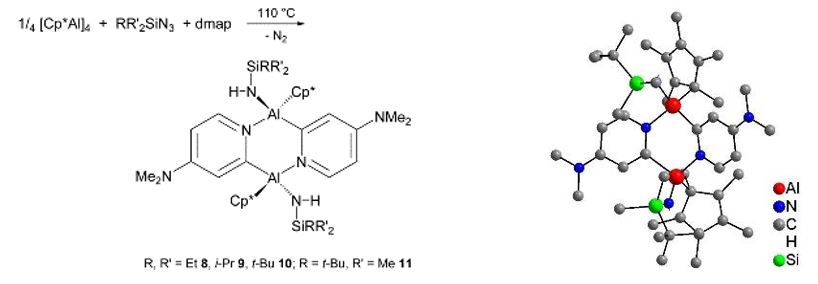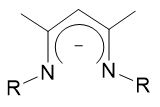Low-valent group 13 compounds
1. Introduction
Low-valent compounds of group 13 elements in the formal oxidation states I ([Cp*M]x (M = Al, Ga, In) and II ([Tms2CHM]2 (M = Al, Ga, In) have experienced in the last two decades a remarkable interest.[1] Alanediyle RAl and their heavy homologues RM (M = Ga, in) are strong Lewis bases. Their basicity increases with increasing π-donating ability of organic substituents.[2] Strong π-donor ligands such as amido- (NR2) and Cp *- substituents can increase substantially the stability of transition metal complexes RM–TMLn or group 13/13 donor-acceptor complexes of the typ RM–M'R'3.[3]
Recent studies highlight the fundamental differences in structural, chemical and electronic properties of heavier main group elements with those of the lighter congeners. Chemists start to realize the “transition metal-like” nature of heavier main group elements from the recently developed molecules that are showing the behavior especially adherent to those of late transition metals: i) stable low-valent derivatives, ii) multiple bonds between heavier main-group elements, iii) molecules with open and quasi-open coordination sites, iv) stable radicals and singlet diradicaliod species. These new species possess frontier orbitals with small energy gaps, a feature of transition-metal complexes. Many of them display diverse reactivities, such as, small molecule activation, oxidative addition, reductive elimination, insertion, trans-metallation, equilibrium reactions, aggregation/catenation (cluster formation) etc. [4]
Reactivity studies of monovalent group 13 complexes
1. Reactions as Lewis base
Reactions of Cp*M (M = Al, Ga, In) with the Lewis acids t-Bu3M (M = Al, Ga) were examined in order to compare the relative basicity of Cp*M with that of triorganostibines and -bismuthines. These studies show that the Lewis basicity decreases steadily from Cp*Al to Cp*.[5]
Homoeleptic group 13/13 complexes can be understood as a valence isomer of the corresponding divalent compounds R2M–MR2. According to DFT calculations, for example, H2Al–AlH2 is about 9.17 kcal/mol more stable than the valence isomer HAl–AlH3, while Cp*Al–AlH3 is about 10.79 kcal/mol more stable than the dialan Cp*(H)Al–AlH2.[6] Even though Cp*Al–AlH3 is up to now unknown, several homonuclear Cp*M-MR3 and heteronuclear complexes Cp*M–M'R3 (M, M' = B, Al, Ga, In) were synthesized and structurally characterized.
2. Oxidation reactions
Reactions of Cp*Al with organosilylazides R3SiN3 resulted in the formation of different iminoalanes [RAlNR]'x, in which the Al and N atoms adopt the coordination number three. These compounds were largely investigated in the past due to their interesting bonding properties, i.e. [MeAlNDipp]3 (Dipp = 2,6-iPr2C6H3), also called alumazene,[7] was described as quasi-aromatic compound according to its structural analogy to borazine B3N3H6, which was synthesized by Stock and Poland for the first time. In addition, several dimeric and monomeric iminoalanes have been synthesized and the critical role of the organic substituents on the resulting structure investigated (kinetical stabilization).[8]
We examined reactions of [Cp*Al]4 with organosilylazides of the type N3SiR'3 (R' = Me, Et, Ph, i-Pr, t-Bu), which yielded at relatively low temperatures dimeric iminoalanes. The addition of the strong Lewis base dmap failed to give the corresponding monomeric, base-stabilized iminoalanes but rather yielded base-stabilized dimeric iminoalanes.[9]
In addition to these Cp*M species, N,N'-chelating ligands such as b-diketiminate ligands of the general type HC[C(Me)NR]2 (= ddp), whose sterical and electronic properties can easily be tuned over a wide range simply be changing the R groups, became were popular for the stabilization of low-valent metal centers in the last decade.[10] (ddp)M ((ddp) = HC[C(Me)NR]2; M = Al, Ga, In) becomes very popular.
(ddp)Al, (ddp)Ga, and (ddp)In are all monomeric species and important reagents in our working group.[11] In recent years, we investigated their reactions with main group metal alkyl reagents as well as with low-valent main group metal complexes.




